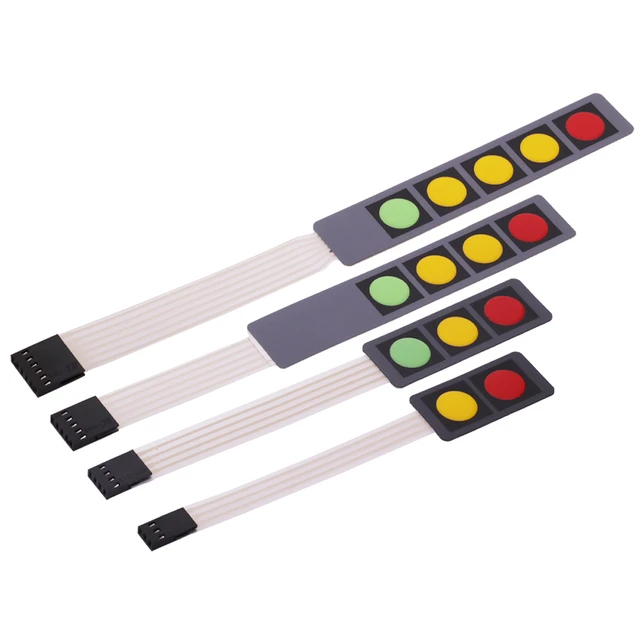Understanding Membrane Switches Over: The Key to Trusted and resilient Controls

What Are Membrane Switches?
Membrane buttons are an innovative option in the world of interface technology, combining functionality and layout seamlessly. These gadgets offer as an interface between individuals and electronic systems, incorporating a number of elements right into a portable format. Typically created from flexible, slim layers of materials, membrane buttons are developed to reply to touch, enabling customers to connect with machinery and electronic devices effectively.
The key aspects of a membrane button consist of a published circuit layer, graphic overlay, and a spacer layer that avoids unintentional activation. The graphic overlay can be personalized to show brand identity or user choices, improving looks while guaranteeing usability. Membrane switches are commonly utilized in various applications, including medical tools, consumer electronic devices, and commercial devices, owing to their durability and resistance to ecological factors such as wetness and dust.
One of the key benefits of membrane layer buttons is their capacity to withstand damage, making them excellent for high-traffic environments. Additionally, they are light-weight and call for marginal area, enabling cutting-edge styles in item development. Generally, membrane layer switches represent a reliable and functional selection for contemporary digital user interfaces, marrying modern technology with user-centric style principles.
Exactly How Membrane Switches Over Job
The procedure of membrane layer switches joints on a basic yet reliable system that converts customer input into electronic signals. When a customer presses the button, the top layer flaws, permitting a conductive aspect in the circuit layer to make call with a matching conductive pad on the underside of the graphic overlay.
The design of membrane layer buttons can vary, but they frequently include domes or responsive elements to give feedback to the customer, enhancing the overall experience - membrane switch. The materials made use of in membrane switches, such as polyester or polycarbonate, add to their sturdiness and resistance to environmental variables, consisting of moisture and dirt. In addition, the printed circuits are normally enveloped, which shields them from deterioration in time.
Advantages of Membrane Layer Switches

Additionally, membrane layer buttons are recognized for their resilience. Created from durable materials, they are resistant to dirt, dampness, and physical wear, which considerably extends their lifespan contrasted to standard mechanical buttons. This resilience makes them particularly ideal for high-traffic settings and applications requiring longevity.
Another substantial benefit is the simplicity of cleaning and upkeep. The smooth surface of membrane changes minimizes dust build-up and is usually resistant to spills, weblink making them ideal for setups that require regular sanitization.
In addition, membrane buttons use a streamlined profile, bring about a thinner design that can be integrated right into numerous gadgets without adding bulk. This feature not only boosts the aesthetic allure however additionally adds to an extra ergonomic product style.
Applications of Membrane Layer Switches
Straightforward and flexible, membrane buttons locate applications throughout a variety of markets, consisting of medical gadgets, customer electronic devices, and industrial devices. In the medical field, these buttons are important to gadgets such as analysis tools, patient tracking systems, and mixture pumps, where dependability and simplicity of cleaning are crucial. Their ability to keep and hold up against rough atmospheres performance makes them ideal for such applications.

In customer electronic devices, membrane buttons are made use of in items like microwaves, washing machines, and push-button controls - membrane switch. Their streamlined design enables for intuitive individual interfaces, boosting the overall customer experience while providing durability and resistance to deterioration
Industrial tools additionally takes advantage of membrane buttons, especially in control panels for machinery and automation systems. These switches use security against dirt and wetness, guaranteeing consistent performance in difficult settings. Furthermore, their adjustable functions allow suppliers to tailor them to details functional needs, improving effectiveness and capability.
Picking the Right Membrane Layer Switch Over
When picking a membrane layer button, it is important to think about numerous factors that affect performance and suitability for specific applications. The main considerations include environmental problems, responsive feedback, longevity, and design requirements.
First, assess the operating atmosphere; buttons exposed to wetness, chemicals, or these details extreme temperatures require details materials to make sure durability and capability. Next, assess the need for responsive feedback. Depending on customer communication, some applications may take advantage of a responsive response to confirm activation, while others might prefer a non-tactile style for aesthetic factors.
Toughness is an additional critical factor; membrane layer buttons ought to be created to hold up against frequent use, influences, and abrasion. Ensure the picked switch can sustain article the anticipated lifecycle, especially in high-usage situations.

Final Thought
In verdict, membrane layer changes offer as important parts in the layout of resilient and trustworthy control systems across various markets. The convenience of membrane layer switches enables for customized services that satisfy details functional needs, reinforcing their importance in modern-day technology.
Membrane layer switches stand for an important element of contemporary user interface layout, blending capability with strength in different applications.Membrane layer buttons are an advanced service in the world of user interface technology, combining capability and design effortlessly. Generally built from adaptable, thin layers of materials, membrane layer switches are designed to respond to touch, enabling individuals to interact with equipment and digital tools effectively.
The design of membrane switches can differ, but they commonly include domes or responsive components to offer feedback to the user, improving the total experience.In verdict, membrane layer switches offer as vital parts in the layout of dependable and long lasting control systems throughout various sectors.